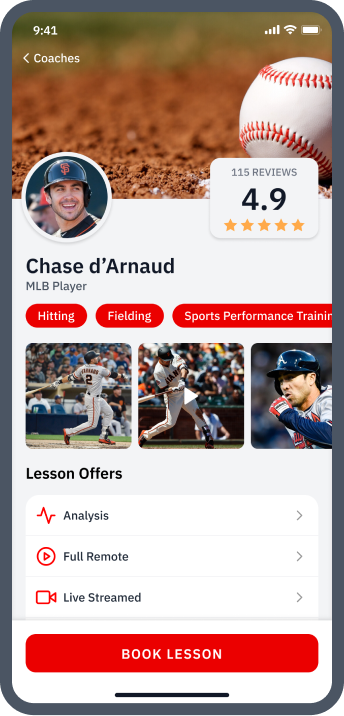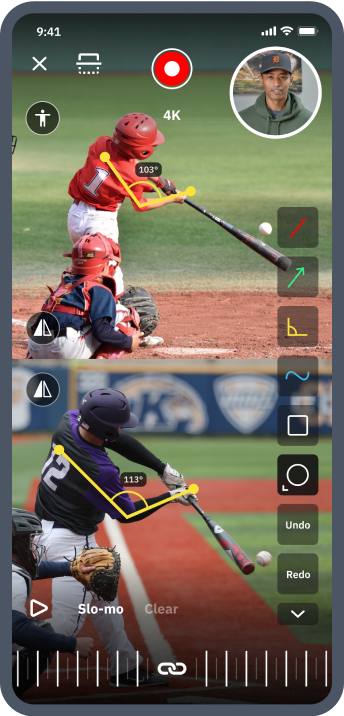Wearable Technology: Does it Have a Place in Baseball & Softball?

In the past several years, wearable devices have become a popular way to track your health and fitness.
Watches, wristbands, heart monitors, and other devices can relay important health data to a smartphone app, clueing you in on your daily habits and improving your overall health.
Or at least that’s the idea.
Wearable tech in the general marketplace of ideas also brings up concerns about information overload and whether we need that much data about ourselves so consistently.
One area where this debate plays out – and where wearable devices have risen greatly in popularity – is athletics.
As more professional sports teams incorporate forms of wearable technology into their training and performance, it begs the question: is there a place for wearable tech in baseball and softball as well?
Before tackling this question head-on, let’s start with some definitions, move into how wearables are being used in other sports – which might be a glimpse into our games’ futures – and then detail some serious pitfalls that may come with these devices.
What Is Wearable Technology?
Wearable technology, or wearables, are electronic devices you can wear on your body.
Unlike smartphones, tablets, or laptops, they’re designed so you don’t have to hold them in your hand or on your lap to use them.
Wearable devices take many forms, such as wristwatches, jewelry, medical devices, or clothing.
Numerous types of devices fall under the wearable devices umbrella.
Some less obvious ones are artificially intelligent hearing aids, Meta or Microsoft’s virtual reality headsets, or disposable skin patches for temporarily collecting and transmitting patient data.

Health and fitness wearables are already popular, letting you see how many steps you take in a day, or tracking your heart rate.
But there's also non-fitness-specific wearables, like augmented reality headsets, that integrate digital information with the user’s environment to enhance their experience are on the rise.
Now that we’re all on the same page definitionally, let’s dive in.
Information overload?
Wearable technology is a growing industry, with new devices coming out all the time.
While wearables provide us with valuable insights into our health and daily activities, it’s possible that they cause information overload.
Many wearables present information to you without much filtering or editing. You’re bombarded with graphs, charts, or other data that you either don’t know how to interpret or don’t really care to in the first place.
Although flooding ourselves with too much information has been a concern throughout history, in today’s digital age it’s getting objectively worse.
There are more than 2.5 quintillion bytes of data created each day, and the information we receive is accelerating.
We take in more than three times as much information today as in 1986.
Wearables, with their constant stream of data, add to this overflow.
Wearable devices can encourage multitasking, which has been proven to work against productivity.
By focusing on several things at once, we over-expend our brain power and have little left over for making important decisions – like whether to swing or take on that 1-2 curveball.
The worst part? We might not even realize when we’re drowning in information.
Thinking of our brain as a limited resource may not come naturally to everyone. But, it’s capacity is finite.
Yes, we all embrace approximations, AKA, probability-informed best guesses, and various biases in order to compensate for the limited capacity of each individual brain.
If you want to learn way more on the topic, we penned The Coach’s Ultimate Guide to Recognizing and Overcoming Cognitive Biases in Baseball and Softball.
And both language and all knowledge preservation technologies are artificially created additives to the original human condition.
These ideas are why some thinkers and scientists regard human societies, which are made up of many brains artificially communicating and preserving knowledge, as actually large artificially intelligent supercomputers.
But, to bring it back down to the individual level of brain workings, according to Harvard Medical School:
Glucose, a form of sugar, is the primary source of energy for every cell in the body. Because the brain is so rich in nerve cells, or neurons, it is the most energy-demanding organ, using one-half of all the sugar energy in the body...Brain functions such as thinking, memory, and learning are closely linked to glucose levels and how efficiently the brain uses this fuel source.
Baseball and softball athletes aren’t able to just eat brain-optimized fuel and sit completely still in contemplation all day every day.
Instead, diverse physical and mental demands are placed on ballplayers both in and outside the game each day.
Which means that both elite players and coaches should consider how they can use the glucose reserves that they’ve taken in as wisely as possible.
Hopefully this quick foreway into science highlights how information overload is more than just a buzzword.
It’s a practical reality worth considering in making smart decisions with your time and energy.
Despite the potential for informational overload, wearable devices have some great benefits, especially in the health and fitness sphere.
And when properly tested and scientifically validated, they could also have a huge impact on elite athletes who want to track their performance.

The History of Wearable Technology in Sports
Soccer has historically been at the forefront of wearable tech.
The first notable breakthrough in wearable sports technology came in 2009, when the European Soccer Club used a real-time monitoring device to track player’s biometrics for signs of exhaustion or injury on the field.
The next notable moment in wearable devices and sports was in 2014, when the Manchester United coach used the Oculus Rift’s virtual reality simulations to let his players experience the 2014 World Cup from other players’ perspectives.
Since these first two instances in wearable sports technology, the industry has grown.
Wearable technologies are now used by athletes, trainers, coaches, and administrators mainly to:
- Monitor athletic training
- Track in-game performance
- Aid recovery after an injury
Many modern wearables are easily applied outside a laboratory setting and can track athletes in a more natural environment.
And when gathering accurate data, having the athlete perform as closely as they would in a competition or game as possible is ideal.

A variety of wearable sports technology
Wearable devices in sports vary greatly.
Devices integrated into sports apparel, built into equipment like bats and balls, and wristbands or patches worn by the athlete are all types of wearables being used today.
Baseball teams are using bat motion sensors to measure and perfect swings, and GPS trackers sewn into uniforms are tracking football players’ balance, speed, and motion.
The sensors and devices athletes use have to be both flexible and durable while producing precise measurements.
If a wristband that tracks heart rate feels too clunky or gets in the way while the athlete trains or competes, it could impede their performance or produce inaccurate results.

Wearable devices have helped improve performance, but an analysis of wearable sports technology from data scientists Yewande Adesida, Enrica Papi, and Alison H. McGregor forwards that it also has tremendous potential for injury prevention.
After looking at what wearable tech has chosen to address so far, these researchers write:
The common themes were injury prevention, performance assessment, movement recognition and skill level classification. Out of these themes, injury prevention is an area with great potential when the cost of injuries and harm to athletes is considered....
To fully exploit this potential in injury prevention, however, there is still a need of identifying which biomechanical data obtained from wearable technology is the most useful as a predictor of injury.
They also pointed specifically to studies on baseball players, where non-commercial accelerometers and gyroscopes were used to assess not only performance but also upper body and elbow torque to look for risks of injury.
The researchers noted, however, that current wearable technology was more often successful in predicting injury, rather than shedding light on changes athletes could make to reduce those injuries.
Progress in this area still has to be made.
Limitations to wearables in sports
In an article for the International Journal of Sports Physiology and Performance, Shona Halson, Jonathan M Peake, and John P Sullivan ask whether wearable technology could help or hinder athletic performance.
They list the major limitations of some current wearable technologies as it concerns athletes:
- Where devices are placed on the body
- Movement artifacts leading to inaccurate data
- Frequency of data sampling
- Monitoring of only a few selected variables to the exclusion of others
- No measurement of environmental factors
- Uncertainty about accuracy of data interpretation
- Inability to always transmit data indoors, underwater, and in built-up areas
- Interference from other physiological responses
They also point out that many wearable technologies that are marketed to athletes and coaches haven’t been properly vetted by sports science experts, or their measurements haven’t been accurately validated.
Halson, Peake, and Sullivan note that athletes – like all of us – are living through a digital age where information is valued. And the more information, the better.
As a result, some athletes and coaches may look past the scientific inaccuracy of wearable devices in an effort to gain an ‘edge’ over the competition.
There are also concerns about privacy, which we’ll address in a bit.

What to look for when considering a wearable technology
When evaluating wearable technology, athletes and coaches should be on the lookout for four things:
- The technology’s primary concern should be doing no harm, so consider the direct implications of the technology on the athlete’s health and safety.
- Athletes and coaches should question the scientific basis of the device.
- If there is no pre-existing scientific evidence, then data on the athlete should be taken in a controlled environment, i.e. not a live game.
- Implications for the athlete – like information overload, unnecessary information, or information that causes undue stress and anxiety – should be another top concern.

Examples of Other Athletes Using Wearable Tech
The market for wearable sports devices is wide, and new products are being developed all the time.
Here are three of the most common types of wearable technology that athletes across other non-baseball or softball sports are using now.
Luckily, this trend is changing with the newest generation of coaches and thought leaders, but looking at what other cutting-edge professional sports teams and players are doing can still reveal potential future applications of the same tech and principles in baseball or softball.
Inertial sensors
Sensors can be placed almost anywhere on the body and their usefulness applies to most sports.
Inertial sensors usually measure three things on the athlete's body:
- Force and acceleration, using accelerometers
- Rotation, with a gyroscope
- Body orientation, with a magnetometer
The three types of data gathered from inertial sensors together try to quantify athlete readiness and fatigue.
The slightest changes in acceleration and movement are detectable with these sensors, so coaches and trainers can see when an athlete’s motions aren’t ‘normal’ and thus predict fatigue or even risk of injury.
Inertial sensors are best at capturing small movements in a tight area.

GPS
Global positioning systems are also used to track athletes’ movements and acceleration on the field, court, etc.
The devices are often worn on the upper back and communicate with GPS satellites. They can track how fast an athlete runs, along with other detailed movements like foot stride.
Although this type of technology is better suited to sports where distance matters as much as speed, like soccer and football, it may have practical applications for baserunners and outfielders in baseball and softball as well.
Heart rate monitor
Heart rate monitors are easy to implement and their data is simple to understand.
Heart rate signifies an athlete’s internal load, showing how they perform when external loads are placed upon their bodies.
Heart rate monitors work best when combined with the other wearables listed.
The Ethical Implications of Wearable Devices
There are ethical dimensions to wearable technology, specifically how the data that’s being collected on you is used.
Many wearable companies will sell your information to third parties, who can use it for advertising purposes.
While monitoring your activity and selling your personal info isn’t exactly new, wearable technology poses a different problem.
Google may track your search history to show you relevant ads, but the wristwatch tracking your heart rate could share the info with your insurance company, causing a rise in premiums.
In one case, a company is selling information you search for. In the other, they’re selling information that’s inherent to who you are, that you have no real control over.
Therein lies the ethical dilemma.
These concerns are no different for athletes, like baseball and softball players.
Many wearable technologies have the capability to know where you are, how long you spent there, and what your heart rate was while you were doing whatever it is you were doing.
Of course, all of this depends on the nature of the device, and whether you wear it on your body over long periods of time or it just attaches to an inanimate object like a bat – the latter being significantly freer from these ethical concerns.
But, if it ever does become the former in baseball, how comfortable would you be with wearables being used as part of the equation to determine draft position or player’s salaries?
While it might seem great to have metrics on-hand related to your baseball or softball performance, you have to ask yourself what cost it presents to your personal privacy.
Especially if it’s wearable technology that hasn’t been fully validated or scientifically backed.
For athletes and anyone interested in wearable technology, there are five major privacy concerns you should consider.

Think about these factors before you purchase any new device:
1. Selling data to third parties
Wearable technology is such a new industry that regulations on selling health information are still murky.
If you live in a state that considers the data the wearable device gathers as protected health information (PHI) then you can reasonably expect the company cannot sell your info.
But if your state doesn’t have such a law or provision in place – and many do not – expect that they can sell your info.
HIPAA regulations don’t extend to wearable technology yet, so all you have to rely on is the company’s terms of service – which can be ambiguous or hard to parse.
At the very least, it’s worth reading the terms of service and privacy policies for wearable products.
2. Security measures
If the company says they protect your information, what does that mean exactly? Do they encrypt it? And who has access to it?
Many privacy policies state that they protect your information from “unauthorized access, use, or disclosure.”
But unless they state how they do that, be at least slightly wary.
3. Public profiles
Most companies that sell wearable technology require you to create a profile. And many of them set your profile to public by default.
Your unprotected PHI could, therefore, become searchable online.
If you don’t want your health information out there for people to find, then always check the privacy settings of your wearable technology profile.
4. HIPAA falls short
Much of the info wearables track aren’t considered protected health information, so they’re not subject to HIPAA regulations when it comes to privacy.
Since it’s not required, many wearable tech companies don’t acknowledge HIPAA or data security laws.
When it comes to protecting your data, then, you don’t have a solid recourse. So take your own safety measures and be responsible for your health data.
5. Who owns your data?
Are you the owner of the data you generate with the wearable device? Or is the company?
Always check the privacy policy before signing up to see if you’ll retain control over your health data or if the company will.

Should Baseball and Softball Players Use Wearable Technology?
Wearable technology does have many positive implications for everyday life as well as athletic use.
However, when using wearable technology to gather data meant to track performance and prevent injury, it’s important for coaches and parents to do their homework.
Some forms of wearable sports tech can be expensive. And if they’re not used properly or you don’t know how to accurately interpret the data, you could be investing for nothing.
All that said, luckily, a few commercial wearable companies are exciting and mostly affordable additions to our game.

Swing & Pitch Analyzers
Currently, the biggest market for wearable tech in baseball and softball is in bat swing analyzers.
These are small devices placed on a bat to track the athlete’s swing and break down essential metrics like bat speed and launch angle.
Again, let’s be extra clear. This type of wearable tech is much more innocuous than those that track personal, internal health.
Many college and professional organizations have adopted bat accelerators and gyroscopes to help add quantifiable data points to things like recruiting and player development – things that had long been quite subjective.
When combined with accurate ball exit speed off of the bat, such devices and their accompanying apps, are a rightfully ubiquitous part of the modern game.
Pitchers are getting the same objective overhaul.
Pitchers can now purchase a ball with a sensor inside from various companies. And these balls can similarly relate and display each pitch’s analysis on an app.
An example for baseball and softball chuckers, is the Pitch Tracker from Diamond Kinetics.

With a remote lessons app, like SeamsUp, video of your ballplayer taken with the wonderful data overlays found on such wearables or devices as Blast Motion, Diamond Kinetics, or Pocket Radar can then be shared directly with a professional baseball or softball coach.
These objective metrics, along with their actual pitching or hitting mechanics, can then be analyzed and tracked by an expert instructor personally who’s invested in the player’s improvement.
VR Training
The newest frontier of baseball and softball wearables is coming in the form of virtual reality hitting and pitching experiences.
Companies such as Applied Vision Baseball & Softball and WinReality pipe their robust in-game simulations through VR headsets, so ballplayers can have full at-bats or participate in pitch recognition drills from their living rooms.
Many collegiate and professional programs have adopted these VR wearables to be used for extra reps without the bodily wear and tear of traditional BP.
And they work particularly well for keeping players who are injured and on DL sharp.
These virtual experiences are also fantastic for youth coaches with limited helpers or training spaces, as an additional hitting station during their team practices.

Conclusion on Whether Wearable Tech Has a Place in Baseball and Softball
Despite their popularity in soccer and American football, it remains to be seen if other more controversial forms of wearable tech, like inertial sensors and GPS, have a place in softball and baseball.
Arguably, the aspects of baseball and softball that require the finest, most precise movements are hitting and pitching, and wearable products to account for these two are already available and rapidly developing.
As of today, it seems likely that if new wearable products come along for our sports, they’ll fall into these same well-established categories – for a while anyway.
Wanna grow your baseball or softball coaching brand?
Get connected to new local and online lesson clients—along with all the tools you need to scale.
Download the free app

About the Author
Courtney Withrow
Professional Writer
Originally from the U.S., Courtney is a Brussels-based freelance writer with a Master’s degree in International Relations. She grew up playing softball and still loves the game.

